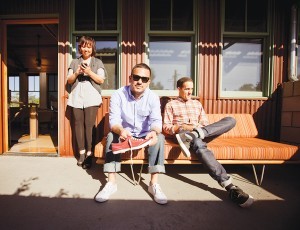
SeaVees has brought back a 1960s sneaker brand. From left, creative adviser Tu Pham, co-founder Derek Galkin, and business operations director Bobby Goodwin. [Jeff Clark photo
They are the creative minds behind the “respectful rehabilitation” of SeaVees, a 1960s sneaker brand that was defunct for half a century before the pair resurrected it and melded it with a cultural history of the Golden State’s most hopeful, and perhaps most tumultuous, decade. In just a few short years, they have landed their classic-styled footwear in high-end retailers such as Neiman Marcus and Barneys New York.
The duo is also living its own California dream. Though Galkin had some startup experience, Tiller had spent most of his career working for bigger corporations in the fashion footwear business. They had always dreamed of a brand they could call their own.
The story goes back to the mid-2000s, when Tiller was executive vice president of product for the Stride Rite Corp., which owns brands such as Keds canvas sneakers, Saucony running shoes and Sperry Top-Siders, the archetypal leather boat shoe. Galkin felt like he’d detected a preppy trend emerging and could help Sperry Top-Sider ride the wave by upping the brand’s price point and making its distribution more exclusive.
When Galkin called the president of Stride Rite, the president found Galkin’s idea interesting because he’d been hearing nearly the same thing from Tiller. He put Tiller and Galkin together to work on the brand.
The pair first met in the Avalon Hotel in Beverly Hills, which was undergoing a massive renovation at the time. “It’s a mid-century classic that’s been updated to today’s standards,” Galkin said. “That will prove to be ironic.”
As the pair talked, they realized they had common aspirations and ethics, both in business and design. They moved forward with work on Sperry Top-Sider and had success but knew from the start they wanted their own brand some day.
“If we were to do it, what would it be?” Galkin remembers asking. “We didn’t want to come up with something contrived. It had to be authentic because males are loyalists. Once we decide on a brand, we become comfortable with it.”
The answer came when Tiller and Galkin were on a trend-spotting trip to Japan. In a glass case at a high-end sneaker retailer in Tokyo, the two found a strange vintage shoe from 1964 they’d never seen before. It was a canvas sneaker with a vulcanized rubber sole — think the ubiquitous Jack Purcell low-top made by Converse — but it had a baby blue sole and an offset heel tag that read “SeaVees.” The lifelong footwear aficionados were baffled and had to buy the pair — for about $500.
A little research revealed that SeaVees was one of three sneaker brands owned by tire maker BF Goodrich in the 1960s to put its excess tire rubber to use. One brand was Jack Purcell, which became a megahit for Converse. The other was PF Flyers, which still exists. And then there was SeaVees.
“They shelved SeaVees,” Galkin said. “How often do you come across a brand that’s been dormant for 50 years?”
Tiller and Galkin bought up all the rights and sat on the idea while they held down their day jobs. They explored the idea more and settled on a brand that would use cultural events from California in the 1960s as a starting point for updating classic designs. The collection is named by dates of events. For example, the 5/66, a Vans-style slip-on sneaker, draws inspiration from May 1966, when the Beach Boy’s seminal “Pet Sounds” album hit shelves.
“California was a feel-good state. At a time when there was a lot of concern and fear, people looked to California,” Galkin said. “It was not the American dream. It was the world dream to live in California.”
From there, the pair made initial sales to Fred Segal in Los Angeles and Jefferies in New York. They’ve kept the distribution to high-end retailers and are in 150 stores and also sell from their website. The shoes aren’t exactly cheap — a lace up boot is the most expensive at $215, and the 5/66 slip-ons go for $135 — but they’re not completely out of reach for the causal hipster.
“SeaVees currently sits next to some of the best brands in the world in some of the most exclusive retail environments in the world, yet you don’t need a fashion guide book to instruct you on how to wear it,” Tiller said in an e-mail from China, where he was traveling for SeaVees meetings. “We want our products to have integrity and be uncompromising in quality yet we don’t want SeaVees to be precious.”
Though the firm is selling hundreds of pairs a month, it’s still limited to just a handful of employees. Tiller said he wants as many people as possible to experience his shoes but wants the brand to grow organically and carefully.
“It’s about being true to our vision, true to the brand,” Tiller said. “SeaVees is still relatively new, and in most circles it’s still the coolest brand you’ve never heard of, so we have a ton of room for growth. We cherish this brand and want to nurture its growth the right way.”
Tiller said he has no regrets so far about breaking away from bigger firms to start his own company.
“There was an entrepreneur inside of me just dying to get out,” Tiller said. “There is great fear in breaking away from the security of a company job to do your own thing, but that fear paled in comparison to the disappointment and regret I’d have to live with if I didn’t chase my dream.”
These days, SeaVees is a passion that consumes Tiller and Galkin and their tiny staff around the clock. “We’re still small enough that every time we sell a pair of shoes [online], I get an email,” Galkin said. “I love it.”
Though it takes a while, Galkin responds to each email with a thank-you note. That’s the kind of personal touch that makes customers feel really engaged with the brand. Many come back for another pair.
“Today we had two people buy two pairs of shoes,” Galkin said. “To me, that’s loyalty.”






 Print
Print Email
Email

















